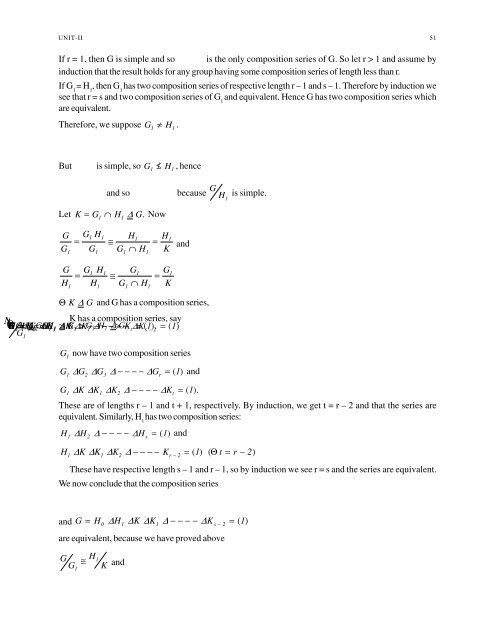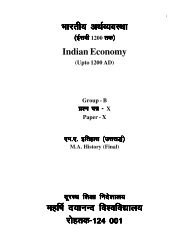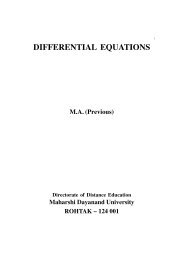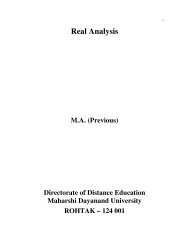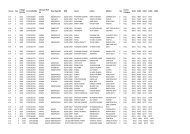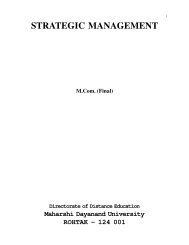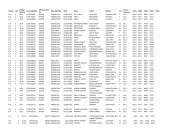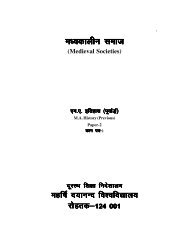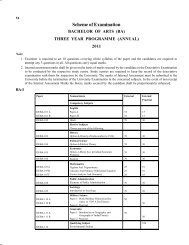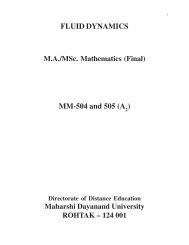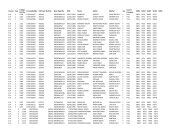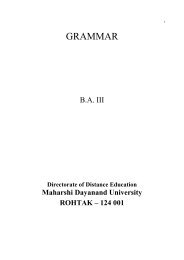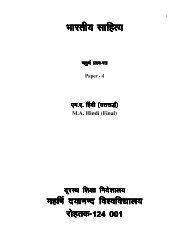Advanced Abstract Algebra - Maharshi Dayanand University, Rohtak
Advanced Abstract Algebra - Maharshi Dayanand University, Rohtak
Advanced Abstract Algebra - Maharshi Dayanand University, Rohtak
You also want an ePaper? Increase the reach of your titles
YUMPU automatically turns print PDFs into web optimized ePapers that Google loves.
UNIT-II<br />
51<br />
If r = 1, then G is simple and so is the only composition series of G. So let r > 1 and assume by<br />
induction that the result holds for any group having some composition series of length less than r.<br />
If G 1<br />
= H 1<br />
, then G 1<br />
has two composition series of respective length r – 1 and s – 1. Therefore by induction we<br />
see that r = s and two composition series of G 1<br />
and equivalent. Hence G has two composition series which<br />
are equivalent.<br />
Therefore, we suppose G<br />
≠ H .<br />
1 1<br />
But is simple, so G1 ≰ H1<br />
, hence<br />
and so<br />
because G H is simple.<br />
1<br />
Let K = G 1<br />
∩ H 1<br />
∆ G. Now<br />
G G1 H1<br />
H1<br />
H1<br />
= ≅ = and<br />
G1<br />
G1<br />
G1 ∩ H1<br />
K<br />
G G1 H1<br />
G1<br />
G1<br />
= ≅ =<br />
H1<br />
H1<br />
G1 ∩ H1<br />
K<br />
Θ K ∆ G and G has a composition series,<br />
HG∆( 1 ) ∆ GH, H G, ∴ G1 H1<br />
∆ G.<br />
1 H<<br />
= 1 1 , K has a composition series, say<br />
∴Θ<br />
GK = KG 0<br />
> ∆GK 1 1<br />
> ∆K 1∆ > K− − ∆ − − > − − K t ∆ = K( s<br />
1 –<br />
). = ( )<br />
G1<br />
NG''∆<br />
0 1 1 2<br />
1<br />
G 1<br />
now have two composition series<br />
G 1<br />
∆G 2<br />
∆G 3<br />
∆ − − − − ∆G r<br />
= ( 1) and<br />
G 1 ∆K ∆K 1 ∆K 2 ∆ − − − − ∆K t = ( 1).<br />
These are of lengths r – 1 and t + 1, respectively. By induction, we get t = r – 2 and that the series are<br />
equivalent. Similarly, H 1<br />
has two composition series:<br />
H 1 ∆H 2 ∆ − − − − ∆H s = ( 1) and<br />
H1 ∆K ∆K1 ∆K2 ∆ − − − − Kr<br />
– 2<br />
= ( 1) ( Θ t = r – 2)<br />
These have respective length s – 1 and r – 1, so by induction we see r = s and the series are equivalent.<br />
We now conclude that the composition series<br />
and G = H0 ∆H1 ∆K ∆K1 ∆ − − − − ∆ K s – 2<br />
= ( 1)<br />
are equivalent, because we have proved above<br />
G G<br />
1<br />
H<br />
≅<br />
1<br />
K and


